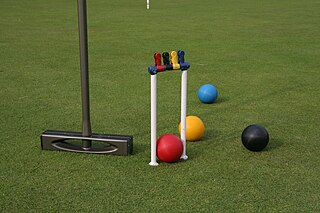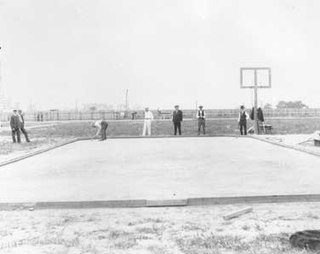Related Research Articles

Cue sports are a wide variety of games of skill played with a cue, which is used to strike billiard balls and thereby cause them to move around a cloth-covered table bounded by elastic bumpers known as cushions.

Badminton is a racquet sport played using racquets to hit a shuttlecock across a net. Although it may be played with larger teams, the most common forms of the game are "singles" and "doubles". Badminton is often played as a casual outdoor activity in a yard or on a beach; formal games are played on a rectangular indoor court. Points are scored by striking the shuttlecock with the racquet and landing it within the other team's half of the court.

Croquet is a sport that involves hitting wooden or plastic balls with a mallet through hoops embedded in a grass playing court.

Field hockey is a team sport structured in standard hockey format, in which each team plays with ten outfield players and a goalkeeper. Teams must drive a round hockey ball by hitting it with a hockey stick towards the rival team's shooting circle and then into the goal. The match is won by the team that scores the most goals. Matches are played on grass, watered turf, artificial turf, synthetic field, or indoor boarded surface.

Tennis is a racket sport that is played either individually against a single opponent (singles) or between two teams of two players each (doubles). Each player uses a tennis racket that is strung with cord to strike a hollow rubber ball covered with felt over or around a net and into the opponent's court. The object of the game is to manoeuvre the ball in such a way that the opponent is not able to play a valid return. The player who is unable to return the ball validly will not gain a point, while the opposite player will.

Table tennis, also known as ping-pong and whiff-whaff, is a racket sport derived from tennis but distinguished by its playing surface being atop a stationary table, rather than the court on which players stand. Either individually or in teams of two, players take alternating turns returning a light, hollow ball over the table's net onto the opposing half of the court using small rackets until they fail to do so, which results in a point for the opponent. Play is fast, requiring quick reaction and constant attention, and is characterized by an emphasis on spin relative to other ball sports, which can heavily affect the ball's trajectory.

Roque is an American variant of croquet played on a hard, smooth surface. Popular in the first quarter of the 20th century and billed "the Game of the Century" by its enthusiasts, it was an Olympic sport in the 1904 Summer Games, replacing croquet from the previous games.

This is a general glossary of the terminology used in the sport of cricket. Where words in a sentence are also defined elsewhere in this article, they appear in italics. Certain aspects of cricket terminology are explained in more detail in cricket statistics and the naming of fielding positions is explained at fielding (cricket).

A billiard ball is a small, hard ball used in cue sports, such as carom billiards, pool, and snooker. The number, type, diameter, color, and pattern of the balls differ depending upon the specific game being played. Various particular ball properties such as hardness, friction coefficient, and resilience are important to accuracy.

In cricket, batting is the act or skill of hitting the ball with a bat to score runs and prevent the loss of one's wicket. Any player who is currently batting is, since September 2021, officially referred to as a batter —regardless of whether batting is their particular area of expertise. Batters have to adapt to various conditions when playing on different cricket pitches, especially in different countries; therefore, as well as having outstanding physical batting skills, top-level batters will have quick reflexes, excellent decision-making skills, and be good strategists.

Extreme Croquet is a variation on croquet mainly distinguished by its lack of any requirement pertaining to out-of-bounds or field specifications. A close relative of the croquet played in most backyards and gardens, but expanded by more adventurous enthusiasts and played throughout the world in conditions unfamiliar to official tournament players.
The following is a glossary of the terminology currently used in the sport of golf. Where words in a sentence are also defined elsewhere in this article, they appear in italics. Old names for clubs can be found at Obsolete golf clubs.
The following is a glossary of traditional English-language terms used in the three overarching cue sports disciplines: carom billiards referring to the various carom games played on a billiard table without pockets; pool, which denotes a host of games played on a table with six pockets; and snooker, played on a large pocket table, and which has a sport culture unto itself distinct from pool. There are also games such as English billiards that include aspects of multiple disciplines.

Gateball is a mallet team sport inspired by croquet. It is a fast-paced, non-contact, highly strategic team game, which can be played by anyone regardless of age or gender. Gateball is most popular in China, Indonesia, Japan, South Korea and Taiwan, with a growing presence in other countries.

Snooker is a cue sport that is played on a baize-covered table with pockets in each of the four corners and in the middle of each of the long side cushions. It is played using a cue and snooker balls: one white cue ball, 15 red balls worth one point each, and six balls of different colours: yellow, green (3), brown (4), blue (5), pink (6), black (7). A player wins a frame of snooker by scoring more points than the opponent(s), using the cue ball to pot the red and coloured balls. A player wins a match when they have achieved the best-of score from a pre-determined number of frames. The number of frames is always odd so as to prevent a tie or a draw.
In the sport of ten-pin bowling, there are many different ways in which to deliver the bowling ball in order to advance it toward the pins in an accurate and powerful manner. Generally, there are three basic forms of 10-pin bowling. The most basic form is known as stroking, which is the most classic form. The most powerful form is known as cranking, which imparts great leverage and maximum rotation on the ball, but sacrifices accuracy. In between the two is the domain of the tweener, who has characteristics of both, but does not truly fit into either category. A well-known variant of "tweening" is the power stroker.

Trucco is an Italian and later English lawn game, a form of ground billiards played with heavy balls, large-headed cues sometimes called tacks, a ring, and sometimes an upright pin. The game was popular from at least the 17th century to the early 20th century, and was a forerunner of croquet, surviving for a few generations after the introduction of the latter.
A Triple Peel (TP) is a standard manoeuvre in top-level games of association croquet.

Ground billiards is a modern term for a family of medieval European lawn games, the original names of which are mostly unknown, played with a long-handled mallet, wooden balls, a hoop, and an upright skittle or pin. The game, which cue-sports historians have called "the original game of billiards", developed into a variety of modern outdoor and indoor games and sports such as croquet, pool, snooker, and carom billiards. Its relationship to games played on larger fields, such as hockey, golf, and bat-and-ball games, is more speculative. As a broader classification, the term is sometimes applied to games dating back to classical antiquity that are attested via difficult-to-interpret ancient artworks and rare surviving gaming artifacts.

Jeu de mail or jeu de maille is an ancient outdoor game, originally from Naples, which gave rise to numerous modern sports, such as golf, croquet, hockey and its variations, and polo. It is a now-obsolete lawn game originating in the Late Middle Ages and mostly played in the Kingdom of Naples and France, surviving in some locales into the 20th century. It is a form of ground billiards, using one or more balls, a stick with a mallet-like head, and usually featuring one or more targets such as hoops or holes. Jeu de mail was ancestral to the games golf, palle-malle and croquet, and, billiards.
References
- ↑ "Chambers's Encyclopaedia: A Dictionary of Universal Knowledge for the People" (1883), p. 485
- 1 2 The Laws of Association Croquet, 6th edition, amended 2008; http://www.croquet.org.uk/association/6th/index.html
- ↑ The Gentleman's Magazine , vol. 225, June–November 1868, p. 236
- ↑ "Cheating, Gender Roles, and the Nineteenth-Century Croquet Craze", Journal of Sport History , Volume 25, Number 3, Fall 1998, p. 406
- ↑ Ray Broadus Browne, Lawrence A. Kreiser (2003) "The Civil War and Reconstruction", ISBN 0-313-31325-3, p. 92, with citations from contemporary sources